Top Rankings
Banning Unified School District ranks among the top 20% of public school district in California for:
Category
Attribute
Community Size
Largest student body (number of students) (Top 1%)
For the 2025 school year, there is 1 public preschool serving 80 students in Banning Unified School District.
Public Preschools in Banning Unified School District have a diversity score of 0.42, which is less than the California public preschool average of 0.74.
Minority enrollment is 89% of the student body (majority Hispanic), which is more than the California public preschool average of 80% (majority Hispanic).
Overview
This School District
This State (CA)
# Schools
11 Schools
47 Schools
# Students
4,310 Students
20,115 Students
# Teachers
201 Teachers
630 Teachers
Student : Teacher Ratio
21:1
21:1
District Rank
Banning Unified School District, which is ranked #1800 of all 1,925 school districts in California (based off of combined math and reading proficiency testing data) for the 2021-2022 school year.
The school district's graduation rate of 84% has increased from 68% over five school years.
Overall District Rank
#1800 out of 1941 school districts
(Bottom 50%)
(Bottom 50%)

Math Test Scores (% Proficient)
10%
33%
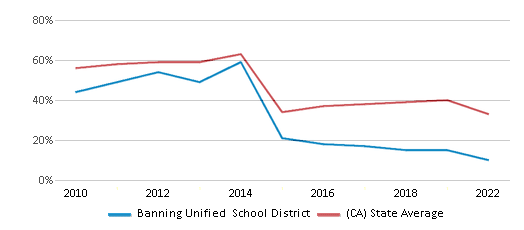
Reading/Language Arts Test Scores (% Proficient)
21%
47%
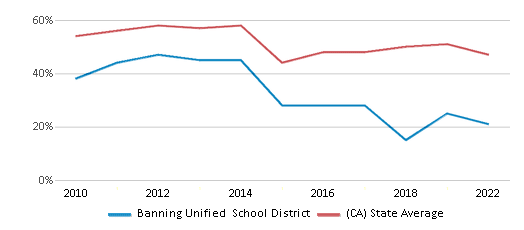
Science Test Scores (% Proficient)
11%
29%
Graduation Rate
84%
87%
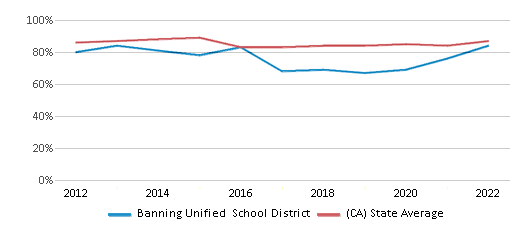
Students by Ethnicity:
Diversity Score
0.43
0.74
# American Indian Students
80 Students
154 Students
% American Indian Students
2%
2%
# Asian Students
188 Students
1,257 Students
% Asian Students
4%
7%
# Hispanic Students
3,230 Students
8,807 Students
% Hispanic Students
75%
44%
# Black Students
282 Students
2,351 Students
% Black Students
7%
12%
# White Students
384 Students
4,154 Students
% White Students
9%
21%
# Hawaiian Students
2 Students
171 Students
% Hawaiian Students
n/a
2%
# Two or more races Students
139 Students
643 Students
% of Two or more races Students
3%
4%
Students by Grade:
# Students in PK Grade:
-
18
# Students in K Grade:
369
4,410
# Students in 1st Grade:
309
1,274
# Students in 2nd Grade:
317
1,228
# Students in 3rd Grade:
310
1,320
# Students in 4th Grade:
374
1,316
# Students in 5th Grade:
347
1,281
# Students in 6th Grade:
326
1,267
# Students in 7th Grade:
364
1,363
# Students in 8th Grade:
319
1,444
# Students in 9th Grade:
301
1,363
# Students in 10th Grade:
310
1,386
# Students in 11th Grade:
338
1,328
# Students in 12th Grade:
326
1,117
# Ungraded Students:
-
-
District Revenue and Spending
The revenue/student of $20,338 is higher than the state median of $19,974. The school district revenue/student has stayed relatively flat over four school years.
The school district's spending/student of $19,457 is higher than the state median of $18,396. The school district spending/student has stayed relatively flat over four school years.
Total Revenue
$88 MM
$116,387 MM
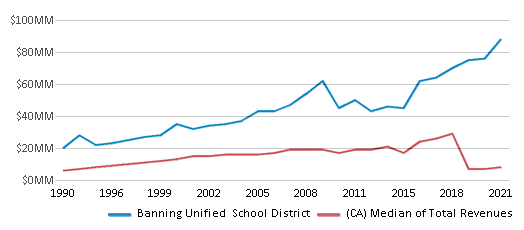
Spending
$84 MM
$107,188 MM
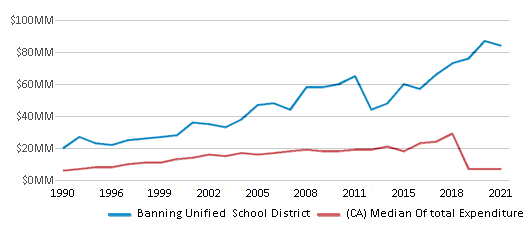
Revenue / Student
$20,338
$19,974
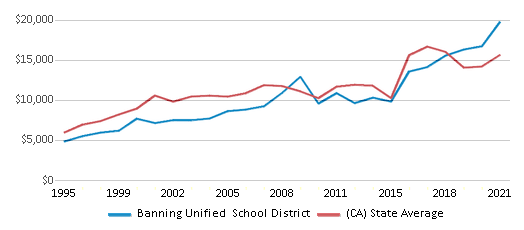
Spending / Student
$19,457
$18,396
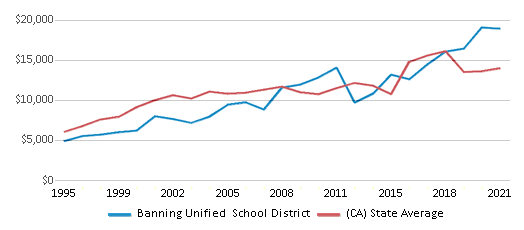
Best Banning Unified School District Public Preschools (2025)
School
(Math and Reading Proficiency)
(Math and Reading Proficiency)
Location
Grades
Students
Rank: n/an/a
671 North Florida St.
Banning, CA 92220
(951) 849-2739
Banning, CA 92220
(951) 849-2739
Grades: K
| 80 students
Recent Articles

Year-Round Or Traditional Schedule?
Which is more appropriate for your child? A year-round attendance schedule or traditional schedule? We look at the pros and cons.

Why You Should Encourage Your Child to Join a Sports Team
Participating in team sports has a great many benefits for children, there is no doubt. In this article you will learn what those benefits are.

White Students are Now the Minority in U.S. Public Schools
Increasing birth rates among immigrant families from Asia and Central and South America, combined with lower birth rates among white families, means that for the first time in history, public school students in the United States are majority-minority. This shift in demographics poses difficulties for schools as they work to accommodate children of varying language abilities and socio-economic backgrounds.





